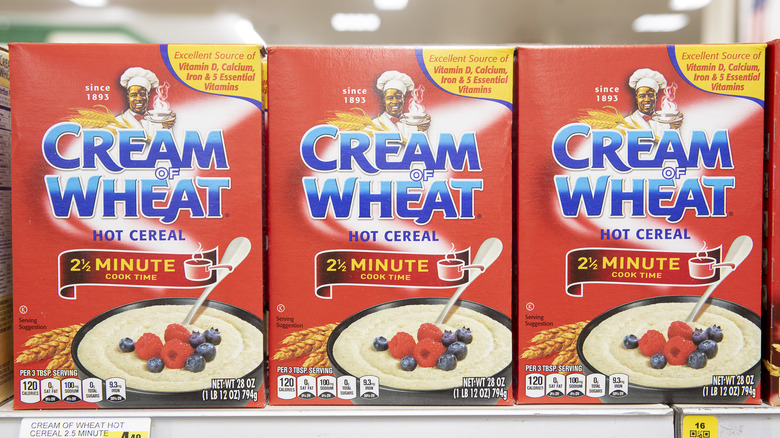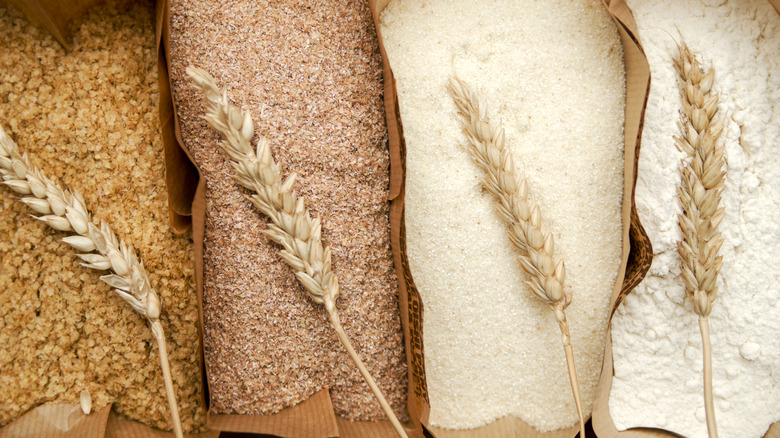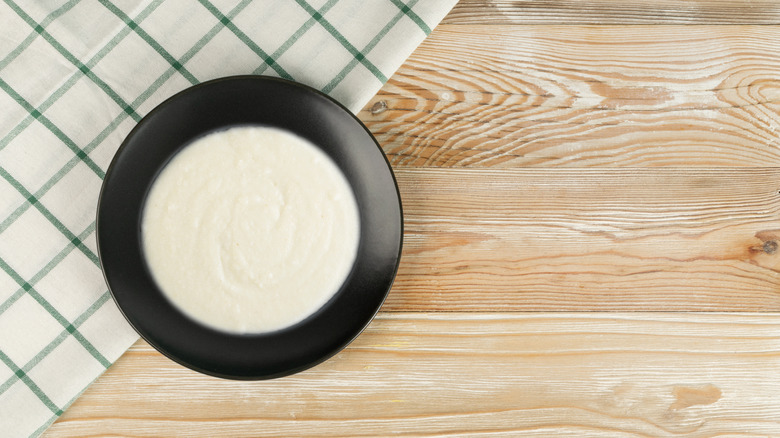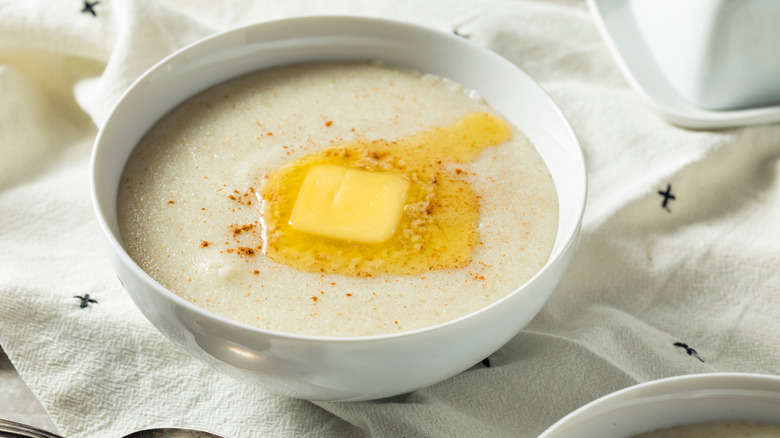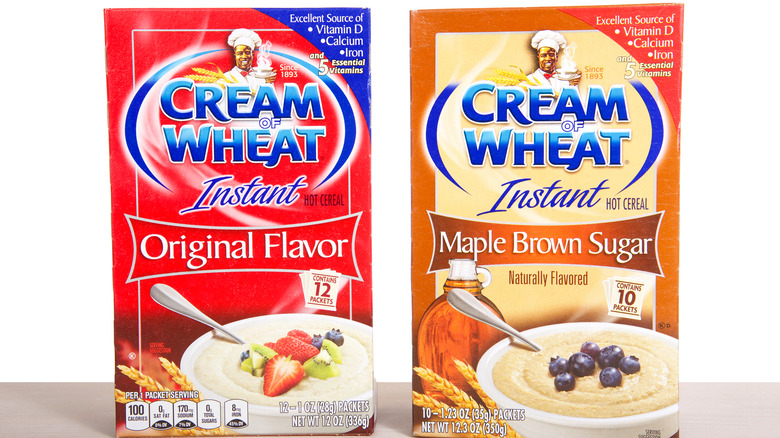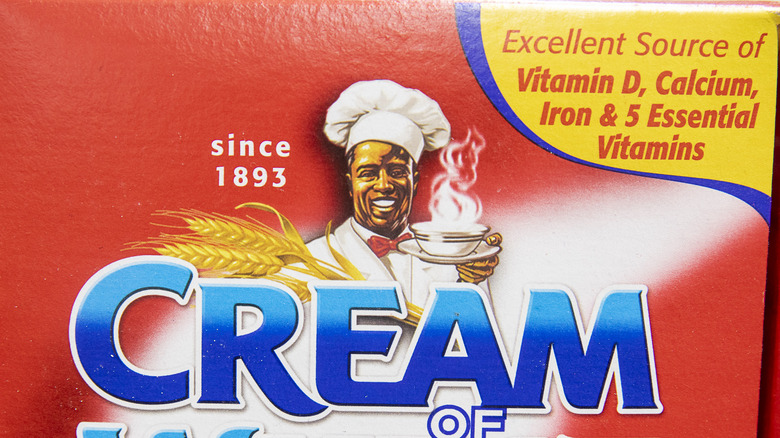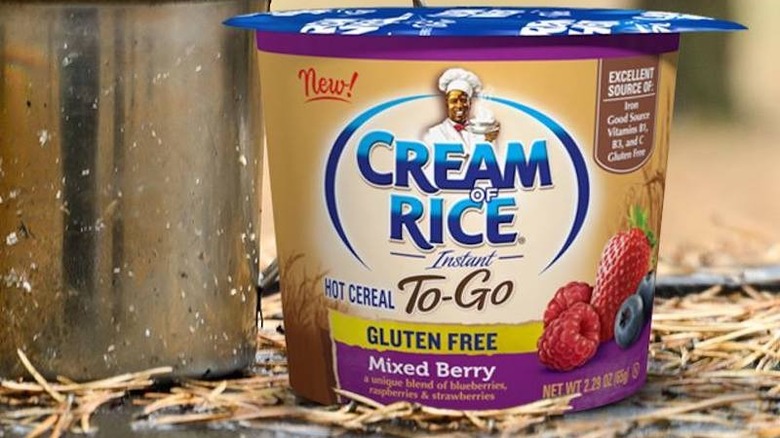The Untold Truth Of Cream Of Wheat
A long-standing breakfast favorite, Cream of Wheat has graced many an American table since it was first released back in 1893 (via MyRecipes). The brainchild of Tom Amidon (whose name, oddly enough, is French for "starch,") Cream of Wheat was first produced at a small flour mill in Grand Forks, North Dakota. Generally referred to as farina cereal, Cream of Wheat is a porridge made from the endosperm of the wheat grain. Per Flour.com, the endosperm is the source of white flour and makes up the bulk of the wheat grain, at about 83% by weight. Cream of Wheat is popular as a delicious, filling breakfast option, and according to its manufacturer's website, it's the most popular hot wheat cereal in the U.S.
Despite its plain-Jane appearance and time-tested crowd-pleasing flavor, Cream of Wheat has a rather colorful history. A pioneer of modern branding techniques (and, unfortunately, a major perpetrator of the racist mascot stereotypes that have finally had their reckoning of late), Cream of Wheat is a prime example of the rich, complex, and occasionally problematic history of American packaged foods.
Cream of Wheat is similar to grits but made with harina rather than corn
Cream of Wheat is a porridge similar in flavor and texture to the Southern staple hot cereal, grits. The one difference? Grits are made with corn, while Cream of Wheat is made with, well, wheat.
Cream of Wheat is the best-known brand name of a product known as farina, which is made by removing the bran from the central endosperm of milled wheat (via MyRecipes). Cooked as a breakfast porridge, this product is popular around the world, for example in Slavic cultures and in Germany, where it is enjoyed warm or cold. While grits do tend to be coarser than Cream of Wheat, in a pinch, the wheat porridge can even stand in for grits, according to Just a Pinch. With the addition of butter and cheese, farina becomes the ideal savory side dish for your favorite Southern recipes like shrimp and grits.
Cream of Wheat is a relatively healthy breakfast option
People are often on the hunt for healthier breakfast foods, and for these folks, Cream of Wheat is a great option. Per MyRecipes, Cream of Wheat starts with mineral-rich wheat that is then enriched with calcium carbonate and ferric phosphate. The nutrition facts on the company's website show that Cream of Wheat is low in calories and high in micronutrients including iron, niacin, vitamin B6, thiamine, riboflavin, and folate, the latter of which is particularly ideal for pregnant women, according to the Centers for Disease Control.
Cream of Wheat is a great option for vegetarians, Healthline notes, as it's a vegan source of iron, usually found in meat, as well as B vitamins, which support, among other things, improved brain health. It's hard to think of a better breakfast choice than a comforting bowl of Cream of Wheat first thing on a chilly winter morning, so it's reassuring that it's healthy too!
Cream of Wheat is easy to make
Cream of Wheat is easy to prepare, and it's versatile to boot. It's traditionally made on the stovetop, cooked in either water or milk. Some people add spices like cinnamon or a pinch of salt for flavor. Others opt to make their lives even easier with a more hands-off cooking method, relying either on the microwave or the slow cooker.
According to Healthline, some of the most common toppings for Cream of Wheat include sugar, maple syrup, fruit, nuts, or spices. The porridge can also be prepared with savory toppings like salt, cheese, or even hot sauce. Others enjoy adding an Indian flair with spices and peas (via Indiaphile).
Cream of Wheat takes on a nutty flavor — and even more health benefits — with a sprinkle of bran or ground flax seeds. A bit of butter alongside whatever toppings you choose, savory or sweet, is always welcome!
Cream of Wheat is a common first food for babies
Cream of Wheat has long been a popular option as a first food for young children because it has a mellow (some might say bland) flavor and it's easy to digest (via Mominformed). According to Can I Give My Baby?, Cream of Wheat is a good choice for babies around six months of age who have just started eating solid foods. Per Near to Nothing, the brand even provides instructions for making Cream of Wheat specifically for babies and toddlers to make it even easier for them to enjoy.
Cream of Wheat boasts lots of health benefits to help babies grow strong, including a decent dose of calcium for healthy bones. Just one word of warning: because this cereal is wheat-based, it could set off allergies in some babies (via Healthy Children). Always be sure to check with your pediatrician before introducing any new foods to your little ones, and if you suspect your child has a wheat allergy or gluten intolerance, steer clear!
There are several varieties and flavors of Cream of Wheat available on the market
Cream of Wheat was once available in just one flavor: plain. Today, there are loads of flavors available, not to mention varieties that make it even easier and faster to prepare.
Cream of Wheat products are marketed first and foremost based on their cooking time. Of the stovetop offerings, both 2 1/2-minute and 1-minute options are available. The brand also sells an Instant product conveniently packaged in single-serving envelopes.
Each type of Cream of Wheat also comes in a rainbow of flavors. Joining the Original plain option are Whole Grain and Maple Brown Sugar versions, as well as Instant offerings like Cinnabon, Bananas & Cream, Maple Brown Sugar with Real Walnuts, Cinna-Apple Walnut with Real Apples, Cocoa Nut with Real Almonds, Banana Walnut, and Mixed Berry with Real Almonds.
For breakfast on the go, Cream of Wheat makes single-serving to-go cups in Maple Brown Sugar Walnut, Cinnabon Cinnamon Sugar, Mixed Berry with Almonds, and Cinna-Apple Walnut varieties. No matter what kind of breakfast you're craving, the brand has an option to suit your mood!
Cream of Wheat's marketing has a racist history
For such a wholesome product, it may be surprising to learn that Cream of Wheat has caused its share of controversy, mostly related to the face of the brand.
Beginning in 1900, the face of Cream of Wheat became a black chef character known as Rastus. Portrayed as ever-cheerful and "barely literate," according to the New York Times, Rastus was a caricature more than true representation, and the character appeared in ads that reinforced contemporary racial prejudices. Rastus' appearance may have been based on a real person who Mid Michigan Genealogical Society researcher Jesse Lasorda identifies as Chicago Chef Frank White, a native of Barbados who emigrated to the U.S. in 1875 and became a citizen 15 years later (via Ferris State University).
In 2020, after many years of unapologetically maintaining the image of Rastus on its packaging, the brand had a reckoning. Like other racially-charged food mascots like Aunt Jemima and Uncle Ben, Rastus was finally removed from the packaging for good.
Food Dive notes that of all of these companies, Cream of Wheat had perhaps the easiest rebrand, given that the product was not named after Rastus, unlike Aunt Jemima's products, Uncle Ben's Rice, or Eskimo Pies. At the same time they announced they were ditching Rastus, B&G Foods, the manufacturer of Cream of Wheat, said that they would fund a scholarship to send Black and Latinx students to culinary school.
Cream of Wheat's ads were created by renowned illustrators
In a time before photographed ads, illustrators provided many of the branding materials for America's best-known products — and Cream of Wheat was no exception. The breakfast cereal was invented during The Golden Age of Illustration, which took hold in the 1880s and lasted into the '40s, with its prime period ending just after World War I (via The R. Atkinson Fox Society). The timing was positively perfect for the porridge to take full advantage of the artistic prowess of American illustrators of the time.
The brand relied on the talents of artists like N.C. Wyeth, J.C. Leyendecker, and Henry Hutt to create beloved ads for the breakfast cereal that you can view on the Cream of Wheat website. The ads, advertising historian and Smithsonian curator Charlie McGovern tells Minnesota Public Radio, often featured children and sought to portray a wholesome image of the American family. This branding decision, he claims, was a huge part of what made the brand so famous and beloved.
Cream of Wheat used to make dolls
In addition to its illustrated ads, Cream of Wheat produced a phenomenal number of household items with the company branding, from cups to bowls to toys like wood blocks and even dolls. Mick Liebfried, who worked at the Minneapolis Cream of Wheat factory for over three decades, tells Minnesota Public Radio that he has amassed "what I think is probably one of the best private Cream of Wheat collections in the entire world." His collection, he says, features 3,000 different items.
The company's reliance on advertising at this scale, according to advertising historian and Smithsonian curator Charlie McGovern, is one of the best early examples of product licensing."Cream of Wheat's achievement is not one of origin but one of success and scale," he tells Minnesota Public Radio. "They used a wide variety of products to advertise their image and they tied in the Cream of Wheat product, the cereal, to a wide array of everyday household items."
The historic Minneapolis Cream of Wheat plant closed in 2002 after nearly a century
While Cream of Wheat was originally invented in North Dakota, the brand moved operations to Minneapolis just four years later, in 1897. According to Historyapolis, the move was a strategic one made to take advantage of better shipping rates and the dependable wheat supply in the town then aptly known as Mill City. Even as Buffalo took Minneapolis' place as the milling capital of the U.S. in the '20s, Cream of Wheat provided excellent opportunities to Minneapolis locals, and business flourished.
Per Inforum, Nabisco acquired the brand in 1961, and the Washington Post reports that Cream of Wheat became part of Kraft Foods' empire with Kraft's acquisition of Nabisco in 2000. Minnesota Public Radio reports that Kraft Foods finally moved Cream of Wheat's production from the Minneapolis factory it had called home since 1928 to plants in Missouri and Ontario, Canada.
Cream of Rice is a similar (gluten-free!) product from the same brand
Cream of Wheat is healthy and mild, but there are some for whom it's not a great choice — those who avoid gluten. Indeed, with wheat as its main ingredient, Cream of Wheat is impossible for those with a wheat allergy or Celiac disease to enjoy.
Enter Cream of Rice.
Cream of Rice is just as creamy and delicious as its sister product, and it's available in a few different varieties including stovetop, instant, and a Mixed Berry to-go cup. Unfortunately, it's less of a nutritional powerhouse than Cream of Wheat: while it's rich in iron, it's devoid of the calcium that makes Cream of Wheat such a healthful option. It does boast some thiamin and niacin, and by adding toppings rich in B vitamins like hemp hearts or antioxidant-rich chia seeds, it can be transformed into a very nutritious breakfast.
